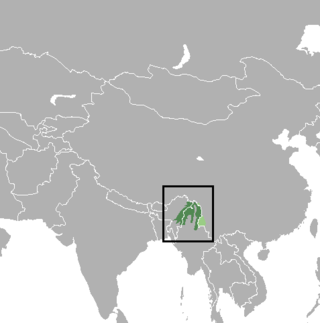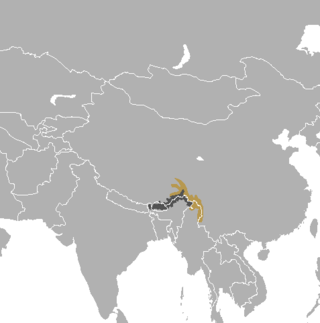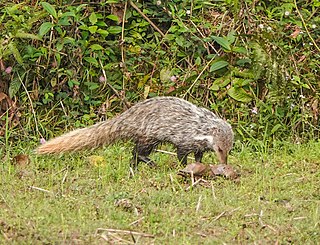
The Japanese serow is a Japanese goat-antelope, an even-toed ungulate. It is found in dense woodland in Japan, primarily in northern and central Honshu. The serow is seen as a national symbol of Japan, and is subject to protection in conservation areas.

The leaf muntjac, leaf deer or Putao muntjac is a small species of muntjac. It was documented in 1997 by biologist Alan Rabinowitz during his field study in the isolated Nogmung Township in Myanmar. Rabinowitz discovered the species by examining the small carcass of a deer that he initially believed was the juvenile of another species; however, it proved to be the carcass of an adult female. He managed to obtain specimens, from which DNA analysis revealed a new cervid species. Local hunters knew of the species and called it the leaf deer because its body could be completely wrapped by a single large leaf. It is found in Myanmar and India.

The Gongshan muntjac is a species of muntjac living in the Gongshan mountains in northwestern Yunnan, southeast Tibet, Northeast India and northern Myanmar.

The Assam macaque or Assamese macaque is a macaque of the Old World monkey family native to South and Southeast Asia. Since 2008, it has been listed as Near Threatened on the IUCN Red List, as it is experiencing significant declines due to poaching, habitat degradation, and fragmentation.

The greater hog badger is a very large terrestrial mustelid native to Southeast Asia. It is listed as Vulnerable in the IUCN Red List of Threatened Species because the global population is thought to be declining due to high levels of poaching.

The barasingha, sometimes barasinghe, also known as the swamp deer, is a deer species distributed in the Indian subcontinent. Populations in northern and central India are fragmented, and two isolated populations occur in southwestern Nepal. It has been extirpated in Pakistan and Bangladesh, and its presence is uncertain in Bhutan.

The crab-eating mongoose is a mongoose species ranging from the northeastern Indian subcontinent and Southeast Asia to southern China and Taiwan. It is listed as Least Concern on the IUCN Red List.

The large Indian civet is a viverrid native to South and Southeast Asia. It is listed as Least Concern on the IUCN Red List. The global population is thought to be decreasing due to hunting and trapping driven by the demand for bushmeat.

Namdapha National Park is a 1,985 km2 (766 sq mi) large protected area in Arunachal Pradesh of Northeast India. The park was established in 1983. With more than 1,000 floral and about 1,400 faunal species, it is a biodiversity hotspot in the Eastern Himalayas. The national park harbours the northernmost lowland evergreen rainforests in the world at 27°N latitude. It also harbours extensive dipterocarp forests, comprising the northwestern parts of the Mizoram-Manipur-Kachin rain forests ecoregion.

The mainland serow is a serow species native to the Himalayas, Southeast Asia and China.
India is home to a large variety of wildlife. It is a biodiversity hotspot with various ecosystems ranging from the Himalayas in the north to the evergreen rain forests in the south, the sands of the west to the marshy mangroves of the east. India lies within the Indomalayan realm and is the home to about 7.6% of mammal, 14.7% of amphibian, 6% of bird, 6.2% of reptilian, and 6.2% of flowering plant species. India's forests contain about 500 species of mammals and more than 1300 bird species.

The serows are four species of medium-sized goat-like or antelope-like mammals of the genus Capricornis. All four species of serow were until recently also classified under Naemorhedus, which now only contains the gorals.

The Sumatran serow, also known as the southern serow, is a subspecies of the mainland serow native to mountain forests in the Thai-Malay Peninsula and on the Indonesian island of Sumatra. It was previously considered its own species, but is now grouped under the mainland serow, as all the mainland species of serow were previously considered subspecies of this species. The Sumatran serow is threatened due to habitat loss and hunting, leading to it being evaluated as vulnerable by the IUCN.

The Himalayan serow, also known as the thar, is a subspecies of the mainland serow native to the Himalayas. It was previously considered its own species, as Capricornis thar. It is the official state animal of the Indian state of Mizoram.
BARAIL Wildlife Sanctuary is located in the southern part of Assam, India, in Cachar district and lies between 24°55΄53΄΄-25°05΄52΄΄ N latitude and 92°27΄40΄΄-93°04΄30΄΄ E longitude. The Dima Hasao part of Barail is not part of this sanctuary. The altitude ranges between 55–1500 m above mean sea level. It spreads over 326.24 km2. The annual average rainfall and temperature range from 2500–4000 mm and 9.2 °C to 36.2 °C respectively; the Humidity varies from 62% to 83%. Field works in Barail area proposed as a national park/sanctuary in 1980s.

Raimona National Park is located in extreme western part of Assam, India. It is spread across Gossaigaon and Kokrajhar subdivisions of Kokrajhar district of BTR.














